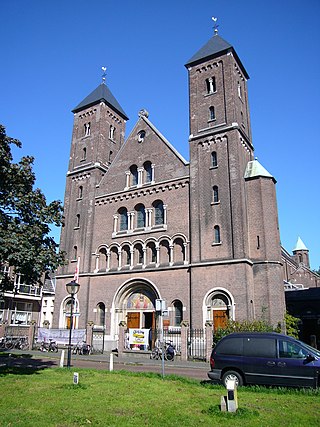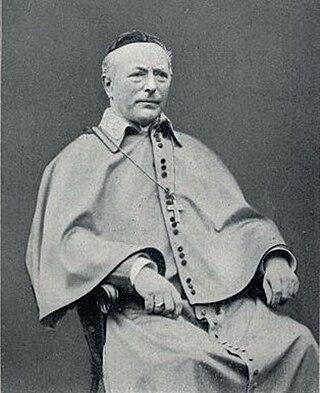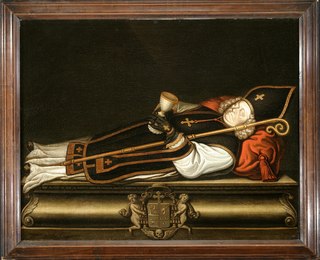Related Research Articles
The terms Old Catholic Church, Old Catholics, Old-Catholic churches or Old Catholic movement designate "any of the groups of Western Christians who believe themselves to maintain in complete loyalty the doctrine and traditions of the undivided church but who separated from the see of Rome after the First Vatican council of 1869–70".

The Old Catholic Church of the Netherlands, sometimes Jansenist Church of Holland, is an Old Catholic jurisdiction originating from the Archdiocese of Utrecht (695–1580). The Old Catholic Church of the Netherlands is the mother church of the Old Catholic Union of Utrecht.
The Holland Mission or Dutch Mission was the common name of a Catholic Church missionary district in the Low Countries during and after the Protestant Reformation.

The Diocese of Nancy and Toul is a Latin Church ecclesiastical territory or diocese of the Catholic Church in France. After a considerable political struggle between Louis XV, Louis XVI, and the Dukes of Lorraine, the diocese was erected by Pope Pius VI on 17 December 1777. The Diocese of Nancy is a suffragan diocese in the ecclesiastical province of the metropolitan Archdiocese of Besançon.

Gerardus Gul served as the seventeenth Archbishop of Utrecht from 1892 to 1920. He is known for his role in assisting the persons who would later found the Polish National Catholic Church in the United States, as well as for consecrating Arnold Harris Mathew, the founder and first bishop of the Old Catholic Church in Great Britain.

Dominique-Marie Varlet was a French prelate and missionary of the Catholic Church who served as vicar general of the Diocese of Quebec. Later, as the Roman Catholic Bishop of Babylon, he caused a schism within the Roman Catholic Church by consecrating four men successively as Archbishop of Utrecht.

The Old Catholic Archdiocese of Utrecht is an archdiocese within the Old Catholic Church of the Netherlands which split from the Archdiocese of Utrecht officially in 1723 because of the illicit consecration of Cornelius van Steenoven to the episcopate.
The historic Diocese of Utrecht (695–1580) was a Roman Catholic diocese and archdiocese in the Low Countries before and during the Protestant Reformation.
Adolphus Louis de Barth Walbach, commonly known as Louis de Barth, was a Roman Catholic priest in Pennsylvania and Maryland. Born and raised in Alsace, he emigrated with his noble family to the United States during the French Revolution. He spent the rest of his life as a priest there, mostly at Conewago Chapel in rural Pennsylvania. After the Bishop of Philadelphia died in 1814, de Barth temporarily led the diocese as apostolic administrator until a new bishop arrived in 1820. After several years at a German-speaking Baltimore parish, he retired to Washington, D.C., in 1841 and died there three years later.

Cornelis van Steenoven was a Dutch Roman Catholic priest who later served as the seventh Old Catholic Archbishop of Utrecht from 1724 to 1725. Consecrated without the permission of the pope, Steenoven was at the center of the 18th-century controversy between national churches and what many considered to be the overreaching powers of the papacy.
Cornelius Johannes Barchman Wuytiers served as the Old Catholic Archbishop of Utrecht from 1725 to 1733.

Theodorus van der Croon (1668–1739) served as the ninth Archbishop of Utrecht from 1734 to 1739.
Petrus Johannes Meindaerts served as the tenth Archbishop of Utrecht from 1739 to 1767. After the death of his consecrator, Bishop Dominique Marie Varlet, Meindaerts consecrated other bishops, such that all later Old Catholic bishops derive their apostolic succession from him.

Walter Michael van Nieuwenhuisen served as the eleventh Archbishop of Utrecht from 1768 to 1797.
Johannes Jacobus van Rhijn served as the twelfth Archbishop of Utrecht from 1797 to 1808.
Johannes van Santen served as the fourteenth Archbishop of Utrecht from 1825 to 1858. He was part of the last attempt of the Church of Utrecht to reconcile with the Roman Catholic Church at that time.
Henricus Loos served as the fifteenth Archbishop of Utrecht from 1858 to 1873. Together with Bishop Hermann Heykamp of Deventer, Loos is known as one of only two bishops whose orders were recognized by the Roman Catholic Church, but who were not invited to the First Vatican Council. Loos served as Archbishop of Utrecht during the first two Old Catholic Congresses in Munich in 1871 and in Cologne in 1872.

Johannes Heykamp served as the sixteenth Archbishop of Utrecht from 1875 to 1892. A learned theologian, Heykamp is most remembered for summoning the conference that led to the Declaration of Utrecht.
Franciscus Kenninck served as the eighteenth Archbishop of Utrecht from 1920 to 1937.

Andreas Rinkel was a Dutch priest who served as the nineteenth Archbishop of Utrecht from 1937 to 1970.
References
Moss, C.B. (1948). The Old Catholic Movement: Its Origins and History. Berkeley, CA: The Apocryphal Press. ISBN 9780976402596.
Neale, Rev. John Mason (1858). A History of the So-called Jansenist Church of Holland. Oxford: John Henry & James Parker. pp. 252–260. ISBN 978-1602066571.